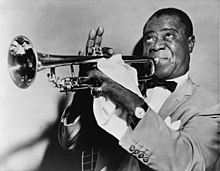
Outline of jazz
| Jazz | |
|---|---|
 Louis Armstrong (1901–1971) is considered one of the pivotal musicians in jazz for his contributions as a trumpet player, composer and singer. | |
| Stylistic origins | |
| Cultural origins | Late 19th-century United States |
| Typical instruments |
|
| Derivative forms |
|
| Subgenres | |
| Fusion genres | |
| Regional scenes | |
| Other topics | |
| |
The following outline is provided as an overview of and topical guide to jazz:

Jazz – musical style that originated at the beginning of the 20th century in African American communities in the Southern United States, mixing African music and European classical music traditions.

Jazz is a music genre that originated from African American communities of New Orleans in the United States during the late 19th and early 20th centuries. It emerged in the form of independent traditional and popular musical styles, all linked by the common bonds of African American and European American musical parentage with a performance orientation.[1]

Jazz spans a period of over a hundred years, encompassing a very wide range of music, making it difficult to define. Jazz makes heavy use of improvisation, polyrhythms, syncopation and the swing note,[2] as well as aspects of European harmony, American popular music,[3] the brass band tradition, and African musical elements such as blue notes and African-American styles such as ragtime.[1]

Although the foundation of jazz is deeply rooted within the black experience of the United States, different cultures have contributed their own experience and styles to the art form as well. Intellectuals around the world have hailed jazz as "one of America's original art forms".[4]

As jazz spread around the world, it drew on different national, regional, and local musical cultures, which gave rise to many distinctive styles. New Orleans jazz began in the early 1910s, combining earlier brass-band marches, French quadrilles, biguine, ragtime and blues with collective polyphonic improvisation.

In the 1930s, heavily arranged dance-oriented swing big bands, Kansas City jazz, a hard-swinging, bluesy, improvisational style and Gypsy jazz (a style that emphasized musette waltzes) were the prominent styles. Bebop emerged in the 1940s, shifting jazz from danceable popular music towards a more challenging "musician's music" which was played at faster tempos and used more chord-based improvisation. Cool jazz developed in the end of the 1940s, introducing calmer, smoother sounds and long, linear melodic lines.

The 1950s saw the emergence of free jazz, which explored playing without regular meter, beat and formal structures, and in the mid-1950s, hard bop emerged, which introduced influences from rhythm and blues, gospel, and blues, especially in the saxophone and piano playing. Modal jazz developed in the late 1950s, using the mode, or musical scale, as the basis of musical structure and improvisation.

Jazz-rock fusion appeared in the late 1960s and early 1970s, combining jazz improvisation with rock music's rhythms, electric instruments and the highly amplified stage sound. In the early 1980s, a commercial form of jazz fusion called smooth jazz became successful, garnering significant radio airplay. Other styles and genres abound in the 2000s, such as Latin and Afro-Cuban jazz.

Types of jazz
Jazz can be described as all of the following:

- Music – art and cultural form whose medium is sound and silence. Its common elements are pitch (which governs melody and harmony), rhythm (and its associated concepts tempo, meter, and articulation), dynamics, and the sonic qualities of timbre and texture. The word derives from Greek μουσική (mousike; "art of the Muses").
- Music genre – conventional category that identifies pieces of music as belonging to a shared tradition or set of conventions. It is to be distinguished from musical form and musical style, although in practice these terms are sometimes used interchangeably.
Musical instruments typically associated with jazz
- Rhythm section instruments
- Drum kit
- Electric guitar
- Jazz bass
- Jazz drumming
- Jazz guitar
- Jazz piano
- "Lead instruments and lead vocals"
- Saxophone
- Trombone
- Trumpet
- Jazz violin
- Vibraphone
- Vocal jazz
- Other
- Banjo (early Dixieland jazz)
- Bass guitar (post 1950s, especially post-1970s)
- Clarinet (early Dixieland jazz and Swing-era jazz)
- Tuba (early Dixieland jazz)
Jazz genres
Jazz fusion

Regional scenes
Local scenes
Jazz compositions
Jazz standards
- Jazz standard – musical composition which is an important part of the musical repertoire of jazz musicians, in that it is widely known, performed, and recorded by jazz musicians, and widely known by listeners. Jazz standards include jazz arrangements of popular Broadway songs, blues songs and well-known jazz tunes.
Jazz discographies
- Blue Note Records discography
- BYG Actuel
- Cobblestone Records
- CTI Records
- ECM
- ESP-Disk
- Flying Dutchman Records
- Freedom Records
- Groove Merchant
- Impulse! Records discography
- India Navigation
- Landmark Records
- Mainstream Records
- Milestone Records discography
- MPS Records discography
- Muse Records discography
- Prestige Records discography
- Riverside Records discography
- Strata-East Records
- Verve Records discography
History of jazz
Stylistic origins
Cultural origins
- Early 1910s New Orleans
Mainstream popularity
- 1920s–1960s, although popularity and development as a genre persists into the present.
Derivatives
- Jump blues
- Rhythm and blues
- Rock and roll
- Ska
- Reggae
- Funk
Years in jazz
Jazz culture
Jazz organizations
Jazz publications
Persons influential in jazz
Jazz musicians
Jazz musicians, by instrument
Jazz musicians, by genre
See also
References
- ^ a b Hennessey, Thomas, From Jazz to Swing: Black Jazz Musicians and Their Music, 1917–1935. PhD dissertation, Northwestern University, 1973, pp. 470–473.
- ^ Alyn Shipton, A New History of Jazz, 2nd edn., Continuum, 2007, pp. 4–5.
- ^ Bill Kirchner, The Oxford Companion to Jazz, Oxford University Press, 2005, Chapter Two.
- ^ Starr, Larry, and Christopher Waterman. "Popular Jazz and Swing: America's Original Art Form." IIP Digital. Oxford University Press, 26 July 2008.
External links
- Jazz Foundation of America
- Jazz @ the Smithsonian
- Encyclopedia of Jazz Musicians
- Alabama Jazz Hall of Fame website
- Jazz Artist and Discography Resource
- Red Hot Jazz.com
- Jazz at Lincoln Center website
- American Jazz Museum website
- The International Archives for the Jazz Organ
- Classic and Contemporary Jazz Music
- The Jazz Archive at Duke University
- Jazz Festivals in Europe
- Free 1920s Jazz Collection available for downloading at Archive.org
- A List of Jazz Lists
- Outline of jazz collected news and commentary at The New York Times
- Outline of jazz collected news and commentary at The Guardian
See what we do next...
OR
By submitting your email or phone number, you're giving mschf permission to send you email and/or recurring marketing texts. Data rates may apply. Text stop to cancel, help for help.
Success: You're subscribed now !
